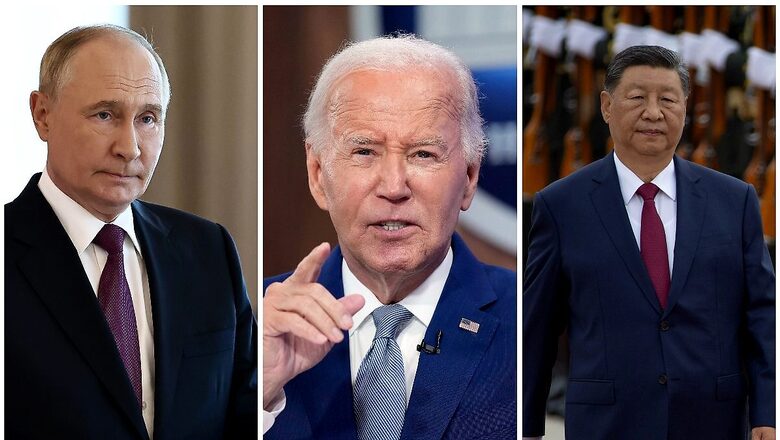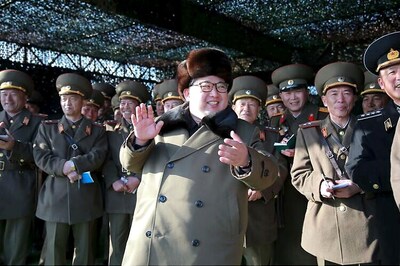
views
War in Ukraine and Showdown Between Israel and Iran Pushes the US’ Back Against the Wall
The world is witnessing a tectonic shift. The era of post-war calm is well on its way out of the window. Instead, what is now clearly visible is the demarcation of pre-war lines, in the sense that opposing blocs and alliances are on the rise. Broadly, the world can now be divided into the Western and Eastern camps. While the US retains leadership over the Western hemisphere, there is a growing consolidation of some major Eastern powers against global American hegemony. The most notable members of this club are China, Russia, Iran and North Korea.
Washington realises that the Indo-Pacific is the next theatre to watch out for. Since World War II, the Americans were solely focused on Europe and countering a supposed threat first from the Soviet Union and then from Russia. With time, the US got embroiled in the Middle East as well, to protect its energy and security interests and keep an eye on the volatile region with active help from Israel. What the Americans did not prepare for, however, was a scenario where the country’s military and strategic resources would be stretched across three conflict theatres.
The Indo-Pacific region has in recent years emerged as a big focus point for the US, with growing attention on countering China’s expanding influence, particularly in the South China Sea and around Taiwan. However, the United States now faces significant complications as two major conflicts—one in Eastern Europe (Ukraine) and another in West Asia (Israel, Iran, and its proxy militias)—demand increasing military and diplomatic resources. This dual-front pressure not only complicates America’s “pivot" to the Indo-Pacific but also opens opportunities for adversaries like China and Russia to exploit.
For example, it was reported in August that for a period of over three weeks, there was no American aircraft carrier group deployed in the Indo-Pacific. This came in the backdrop of rising tensions between Israel and Iran following the elimination of Ismail Haniyeh in Tehran. The absence of any American carrier strike group in the Indo-Pacific for several weeks gives China just the opportunity it needs to launch an attack on Taiwan.
Shifting Military and Resource Allocation
America’s military strategy is built on the concept of projecting power globally, but doing so requires prioritising certain regions based on the geopolitical climate. Prior to the Ukraine war, the US had already begun reallocating military resources and diplomatic focus to the Indo-Pacific as part of its pivot. This included joint military exercises with regional partners like India, Japan, and Australia (QUAD), naval operations in the South China Sea, and bolstering Taiwan’s defences. A separate alliance, focused on more manifest military cooperations – the AUKUS – was also launched.
However, Russia’s invasion of Ukraine in early 2022 forced the US to increase its military and financial commitments to Europe, particularly to Kyiv. Billions in aid, advanced weaponry, and intelligence-sharing capabilities have been directed toward Ukraine, limiting Washington’s capacity to really push ahead with its pivot to Asia.
More recently, the resurgence of conflict in West Asia, particularly between Israel and Iran, has complicated matters dramatically. In fact, Washington now has to deal with an unprecedented situation with Israel and Iran directly exchanging blows. With Israel set to retaliate for Iran’s large-scale missile attack, there is a real possibility of an all-out war breaking out between both countries. Unlike Ukraine, this is a war that the US will definitely be dragged into.
That will make Xi Jinping a very happy man in China. His friend in Moscow, Vladimir Putin, will let out a smile as well.
The recent rise in tensions in West Asia has made America’s Indo-Pacific policy more fragile, with fewer resources available to counter China’s increasingly assertive behaviour in the region. A prolonged conflict in West Asia, especially an all-out war between Israel and Iran could further erode US military strength, leaving the Indo-Pacific vulnerable.
China’s Opportunistic Expansion
With Washington’s attention divided between Ukraine and West Asia, Beijing sees an opening to further its goals, particularly in the South China Sea and against Taiwan. China has ramped up its naval presence and continues to build artificial islands with military infrastructure in disputed waters. In recent months, Chinese fighter jets have made more aggressive incursions into Taiwan’s air defence identification zone. Chinese coast guard vessels have been harassing Philippian ships, and even ramming into them without any fear of international law.
China’s calculated moves may be emboldened by the perception that the US lacks the capacity to effectively intervene, especially as its military resources are stretched thin and between different areas. Beijing could push the envelope in Taiwan, relying on the assumption that the US will be hesitant to engage in another potential conflict zone while simultaneously handling Ukraine and West Asia. This plays into China’s long-term strategy of asserting dominance in the Indo-Pacific.
The Evolving Russia-Iran-China Axis
The emerging cooperation between Russia, Iran, and China (RIC) complicates the geopolitical landscape further. Each of these powers has a vested interest in undermining American dominance, and their alignment serves mutual goals. Russia, bogged down in Ukraine but benefiting from the divided global focus, is more than willing to partner with China in destabilising American influence in Asia. Iran’s entanglements in West Asia also help draw the USA’s attention away from Europe, indirectly benefiting Russia’s war efforts.
This growing relationship between Russia, Iran, and China creates a new axis that threatens to reshape power balances across multiple regions. The coordination between Russia and Iran, evident through arms deals and military support, not only strengthens Iran’s position in West Asia but also allows Russia to circumvent Western sanctions. China, as the economic powerhouse in this axis, provides critical financial support and offers diplomatic cover on international platforms.
As this ‘RIC’ alignment grows, America faces a scenario where its adversaries collaborate across multiple theatres — Europe, West Asia, and the Indo-Pacific. Each partner within this axis stands to gain from a prolonged US distraction, whether it’s China’s ambitions in the South China Sea or Russia’s objectives in Ukraine.
Implications for the US’s Strategy
America’s Indo-Pacific strategy hinges on its ability to maintain a dominant and consistent military presence. However, with resources stretched across multiple conflict zones, its ability to deter China in the region is weakened. The US risks losing ground in the Indo-Pacific if it cannot find ways to manage its military commitments more efficiently. If China continues its opportunistic expansion while the US is distracted, the long-term consequences for regional security could be profound.
Moreover, the rise of an informal Russia-Iran-China alliance represents a significant geopolitical challenge. The collaboration between these states could embolden China to act more aggressively, knowing that US capabilities are diluted by its involvement in other regions. Similarly, Russia stands to benefit as the West’s attention is diverted from Ukraine, allowing Putin to potentially push forward without facing the same level of international pressure.
All of this begs the question: are the rising tensions in West Asia organic, or are there some powers behind the curtains who want the US to be embroiled in multiple conflicts, thereby shifting Washington’s focus away from the Indo-Pacific?
Views expressed in the above piece are personal and solely those of the author. They do not necessarily reflect News18’s views.





















Comments
0 comment